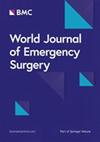Systematic review and meta-analysis of endovascular therapy versus open surgical repair for the traumatic lower extremity arterial injury
IF 5.8
1区 医学
Q1 EMERGENCY MEDICINE
引用次数: 0
Abstract
For traumatic lower extremity artery injury, it is unclear whether it is better to perform endovascular therapy (ET) or open surgical repair (OSR). This study aimed to compare the clinical outcomes of ET versus OSR for traumatic lower extremity artery injury. The Medline, Embase, and Cochrane Databases were searched for studies. Cohort studies and case series reporting outcomes of ET or OSR were eligible for inclusion. Robins-I tool and an 18-item tool were used to assess the risk of bias. The primary outcome was amputation. The secondary outcomes included fasciotomy or compartment syndrome, mortality, length of stay and lower extremity nerve injury. We used the random effects model to calculate pooled estimates. A total of 32 studies with low or moderate risk of bias were included in the meta-analysis. The results showed that patients who underwent ET had a significantly decreased risk of major amputation (OR = 0.42, 95% CI 0.21–0.85; I2=34%) and fasciotomy or compartment syndrome (OR = 0.31, 95% CI 0.20–0.50, I2 = 14%) than patients who underwent OSR. No significant difference was observed between the two groups regarding all-cause mortality (OR = 1.11, 95% CI 0.75–1.64, I2 = 31%). Patients with ET repair had a shorter length of stay than patients with OSR repair (MD=-5.06, 95% CI -6.76 to -3.36, I2 = 65%). Intraoperative nerve injury was just reported in OSR patients with a pooled incidence of 15% (95% CI 6%–27%). Endovascular therapy may represent a better choice for patients with traumatic lower extremity arterial injury, because it can provide lower risks of amputation, fasciotomy or compartment syndrome, and nerve injury, as well as shorter length of stay.创伤性下肢动脉损伤的血管内治疗与开放手术修复的系统回顾和荟萃分析
对于创伤性下肢动脉损伤,目前尚不清楚是进行血管内治疗(ET)更好,还是进行开放手术修复(OSR)更好。本研究旨在比较创伤性下肢动脉损伤的 ET 与 OSR 的临床疗效。研究人员在 Medline、Embase 和 Cochrane 数据库中检索了相关研究。报告 ET 或 OSR 结果的队列研究和病例系列研究符合纳入条件。采用Robins-I工具和18项工具评估偏倚风险。主要结果为截肢。次要结果包括筋膜切开术或筋膜室综合征、死亡率、住院时间和下肢神经损伤。我们使用随机效应模型计算汇总估计值。共有32项存在低度或中度偏倚风险的研究被纳入荟萃分析。结果显示,与接受OSR的患者相比,接受ET的患者发生大截肢(OR=0.42,95% CI 0.21-0.85;I2=34%)和筋膜切开术或室间综合征(OR=0.31,95% CI 0.20-0.50,I2=14%)的风险明显降低。两组患者的全因死亡率无明显差异(OR = 1.11,95% CI 0.75-1.64,I2 = 31%)。ET修复术患者的住院时间短于OSR修复术患者(MD=-5.06,95% CI -6.76至-3.36,I2=65%)。据报道,OSR患者术中神经损伤的发生率为15%(95% CI 6%-27%)。血管内治疗可能是外伤性下肢动脉损伤患者的更好选择,因为它可以降低截肢、筋膜切开或筋膜室综合征和神经损伤的风险,并缩短住院时间。
本文章由计算机程序翻译,如有差异,请以英文原文为准。
求助全文
约1分钟内获得全文
求助全文
来源期刊

World Journal of Emergency Surgery
EMERGENCY MEDICINE-SURGERY
CiteScore
14.50
自引率
5.00%
发文量
60
审稿时长
10 weeks
期刊介绍:
The World Journal of Emergency Surgery is an open access, peer-reviewed journal covering all facets of clinical and basic research in traumatic and non-traumatic emergency surgery and related fields. Topics include emergency surgery, acute care surgery, trauma surgery, intensive care, trauma management, and resuscitation, among others.
 求助内容:
求助内容: 应助结果提醒方式:
应助结果提醒方式:


